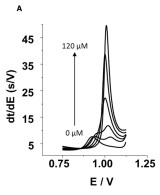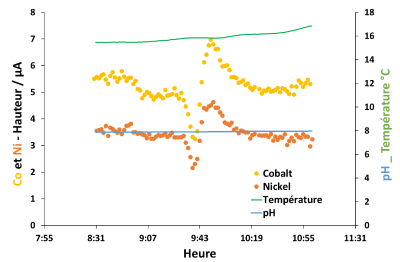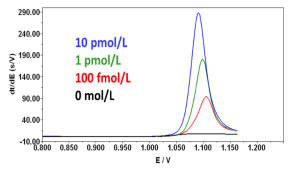Towards an ultra-sensitive electrode to detect glyphosate in water continuouslyEnd of the E2S “CAPTAIN Ad Hoc” research project


The aim of the project was to develop an electrochemical sensor to detect, in situ and immediately, pesticide residues such as glyphosate, which are frequently found in aquatic environments. Various tests were undertaken to detect glyphosate using a screen-printed carbon electrode modified with gold nanoparticles. Optimization of measurement conditions enabled glyphosate detection to be validated.
However, regardless of the conditions under which the gold nanoparticles were deposited and the nanostructures generated, a detection limit of 4 micromoles per liter was obtained, a value still too high for direct application in the environment.

Improved sensitivity and specificity
Furthermore, this gold-film-modified electrode proved to be extremely sensitive to the presence of other ions in the solution. In order to improve sensor specificity and limit interference, a functional modification of the electrode with an aptamer (a synthetic antibody functioning as a lock-and-key system) was undertaken as part of Mohamed Amine Berkal's thesis. This work showed that, whatever the aptamer considered, grafting an aptamer onto the electrode surface failed to detect the targets of interest because their molecular size was too small to generate sufficient signal modification for quantification.
Prototype and fieldwork
In parallel, a flow analysis system and a 3-electrode industrial sensor were designed for continuous analysis:
A field campaign took place at the pilot rivers managed by TotalEnergies' Lacq Study and Research Pole (PERL) as part of the Ecotox Chair held by Séverine Le Faucheur. The targets monitored were therefore the metals of interest to the Chair, namely cobalt and nickel.

This campaign demonstrated the stability of the sensor over 24 hours, the significant effect of temperature on the cobalt signal, and the good sensitivity of the sensor to a particular event. A publication in the Journal of Environmental Chemical Engineering is currently under review.


Between 2017 and 2024, the I-SITE has financed a number of partnership research projects, including scientific challenges designed to develop innovative topics and reduce technological barriers.








